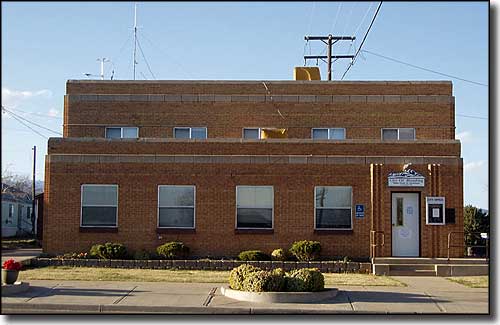
Blanding, Utah

Blanding city offices
Blanding was founded in 1905 as the town of Grayson. The name was changed in 1914 when a wealthy easterner offered to donate a 1,000-volume library to any town that would adopt his name. Grayson and Thurber (both towns in Utah) competed for that prize. Thurber renamed itself "Bicknell" (for Thomas W. Bicknell, the donor) while Grayson became "Blanding" (after the maiden name of Bicknell's wife). Both towns received 500 books for their public libraries.
Blanding is in San Juan County, near the Navajo Nation and the White Mesa Ute Community. As the area was first settled in the 1880's by Mormon settlers (part of the famous Hole-in-the-Rock expedition), many of Blanding's residents have family ties to the nearby reservations. While most folks in the area make their living with mining, mineral processing, agriculture, transportation, local commerce and tourism, Blanding is probably best known as the gateway to a number of nearby natural and archaeological resources. Natural Bridges National Monument, the Four Corners, Monument Valley, Glen Canyon National Recreation Area, Goosenecks State Park, Canyonlands National Park and the Cedar Mesa archaeological and wilderness area are all close by, with Edge of the Cedars State Park Museum located within the city limits of Blanding. About 1 hour north is Moab and Arches National Park. To the southeast is Hovenweep National Monument. Because of its location in the center of what is probably North America's greatest archaeological treasure chest, Blanding is also in the heart of federal government actions to stop the looting and pillaging of ancient Native American cultural artifacts.
Latitude: 37.6232°N
Longitude: 109.4789°W
Founded: 1905
Elevation: 6,106'
Education:
High School or Higher: 85.9%
Bachelor's Degree or Higher: 22.4%
Graduate or Professional Degree: 6.4%
2011 Cost of Living Index for Blanding: 82.5
Median Resident Age: 24.3 Years
Estimated Median Household Income: $37,200
Estimated Median Home Value: $117,500
Population Density: 1,387 People per Square Mile
Major Industries:
Educational Services, Health Care, Construction, Lodging & Food Services, Government, Social Services, Retail Services, Mining, Professional Services
Unemployed (March 2011): 13.6%
Population Demographics: 2010
| Total Population | 3,375 |
| Males | 1,647 |
| Females | 1,728 |
| Population by Age | |
| Under 18 | 1,181 |
| 18 & over | 2,194 |
| 20-24 | 295 |
| 25-34 | 425 |
| 35-49 | 490 |
| 50-64 | 461 |
| 65 & over | 378 |
| Population by Ethnicity | |
| Hispanic or Latino | 128 |
| Non Hispanic or Latino | 3,247 |
| Population by Race | |
| White | 2,232 |
| African-American | 11 |
| Asian | 9 |
| Native American | 993 |
| Hawaiian or Pacific Islander | 2 |
| Other | 18 |
| Two or more | 110 |
